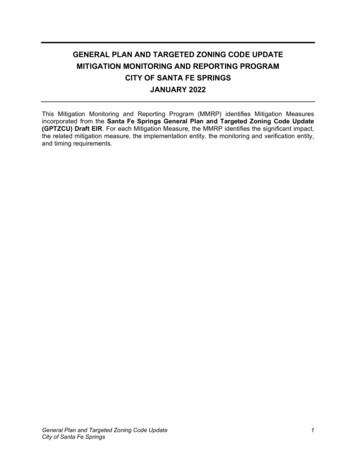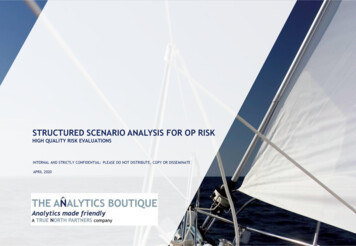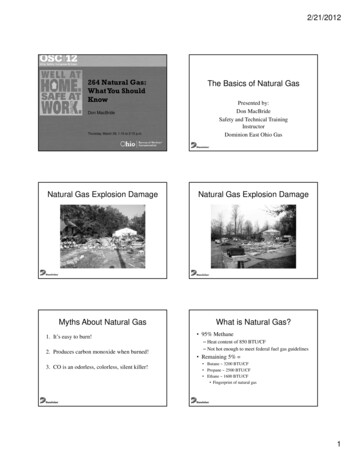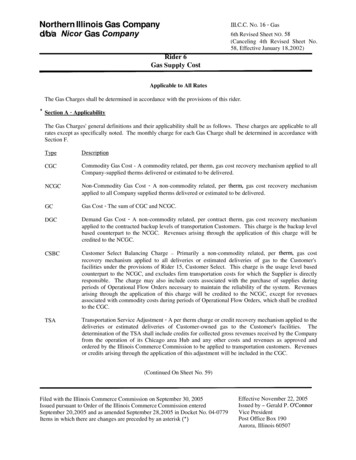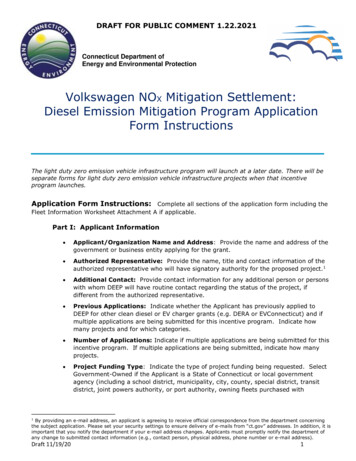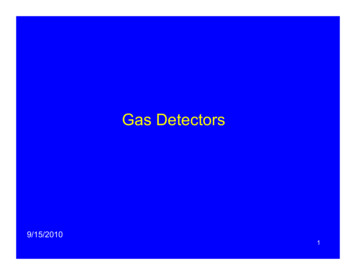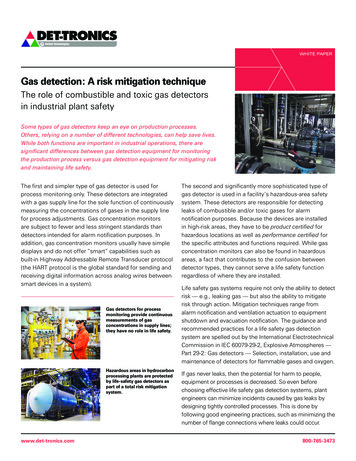
Transcription
WHITE PAPERGas detection: A risk mitigation techniqueThe role of combustible and toxic gas detectorsin industrial plant safetySome types of gas detectors keep an eye on production processes.Others, relying on a number of different technologies, can help save lives.While both functions are important in industrial operations, there aresignificant differences between gas detection equipment for monitoringthe production process versus gas detection equipment for mitigating riskand maintaining life safety.The first and simpler type of gas detector is used forprocess monitoring only. These detectors are integratedwith a gas supply line for the sole function of continuouslymeasuring the concentrations of gases in the supply linefor process adjustments. Gas concentration monitorsare subject to fewer and less stringent standards thandetectors intended for alarm notification purposes. Inaddition, gas concentration monitors usually have simpledisplays and do not offer “smart” capabilities such asbuilt-in Highway Addressable Remote Transducer protocol(the HART protocol is the global standard for sending andreceiving digital information across analog wires betweensmart devices in a system).Gas detectors for processmonitoring provide continuousmeasurements of gasconcentrations in supply lines;they have no role in life safety.Hazardous areas in hydrocarbonprocessing plants are protectedby life-safety gas detectors aspart of a total risk mitigationsystem.www.det-tronics.comThe second and significantly more sophisticated type ofgas detector is used in a facility’s hazardous-area safetysystem. These detectors are responsible for detectingleaks of combustible and/or toxic gases for alarmnotification purposes. Because the devices are installedin high-risk areas, they have to be product certified forhazardous locations as well as performance certified forthe specific attributes and functions required. While gasconcentration monitors can also be found in hazardousareas, a fact that contributes to the confusion betweendetector types, they cannot serve a life safety functionregardless of where they are installed.Life safety gas systems require not only the ability to detectrisk — e.g., leaking gas — but also the ability to mitigaterisk through action. Mitigation techniques range fromalarm notification and ventilation actuation to equipmentshutdown and evacuation notification. The guidance andrecommended practices for a life safety gas detectionsystem are spelled out by the International ElectrotechnicalCommission in IEC 60079-29-2, Explosive Atmospheres —Part 29-2: Gas detectors — Selection, installation, use andmaintenance of detectors for flammable gases and oxygen.If gas never leaks, then the potential for harm to people,equipment or processes is decreased. So even beforechoosing effective life safety gas detection systems, plantengineers can minimize incidents caused by gas leaks bydesigning tightly controlled processes. This is done byfollowing good engineering practices, such as minimizing thenumber of flange connections where leaks could occur.800-765-3473
White PaperPage 2MATCHING DETECTION CAPABILITIES WITHREQUIREMENTSPlant owners and operators first need to understandwhether the area they are planning for needs gasdetection for process monitoring or for risk mitigationand life safety. (See Figure 1 below.) One need for riskmitigation is within hazardous-area classified locations, perChapter 5 of the National Electrical Code (NEC), NationalFire Protection Association (NFPA 70 ). Areas deemedClass I are those where flammable gases, flammableliquid-produced vapors or combustible liquid-producedvapors are or may be present in the air in quantitiessufficient to produce explosive or ignitable mixtures.Class I Division 1 is a location where combustiblematerials are routinely present in ignitable concentrations,while Class I Division 2 is a location in which the samematerials are handled, processed or used, but in whichthe materials are normally confined and can escape onlyin case of accident or breakdown or failure or abnormaloperation of ventilation equipment.A gas detector located in an area for risk mitigationand life safety must be Class I Division 1 hazardousarea certified in order to ensure explosion safety evenin the unlikely event of containment failure. In addition,the risk mitigation and life safety gas detector must beperformance certified in order to ensure proper safetyactions are taken to mitigate the situation.However, a gas monitoring detector can be Class IDivision 2 hazardous-area certified to monitor a containedprocess if the area is classified as Class I Division 2 and noperformance certification is necessary due to non-safetypurpose. It is important to note that maintenance of thesegas monitoring devices requires physical access, whichrequires decommissioning an area and can in turn resultin costly plant downtime. To avoid process interruptions,some facilities instead elect to use devices appropriate forClass I Division 1, choosing higher-capability and lowerlife-cycle costs over lower initial cost.Figure 1RISK MITIGATION OBJECTIVES — GAS DETECTION TYPE REQUIREDRisk Mitigation and Life SafetyGas DetectionObjectivesPriority #1Explosion PreventionPriority #2Personnel ProtectionPriority #3Equipment ProtectionPriority #4Process ProtectionCombustible Gas Process MonitoringGas DetectionNotesToxic Gas1. Gas detectors for risk mitigation can also be used forvalidation of area classification (e.g. less than 10 hoursflammable atmosphere exposure per year).1. Limits for short- and long-term exposure to toxic gas havebeen set by agencies such as Occupational Safety andHealth Administration in the U.S. and Control of SubstancesHazardous to Health in the UK. 1. A gas-related equipment explosion will likely also pose athreat to people. 1. Gas detectors for risk mitigation and life safety are neededoutside of gas-carrying pipes to detect leaks that could posea threat to personnel, equipment or facility.2. Gas detectors for process monitoring are needed to maintainproduction control.From a risk mitigation perspective, there is a hierarchy of risk that should be considered when designing a plant’s hazardous-area gasdetection system. The risk mitigation objectives are ranked in priority order, based on severity of risk; the type or types of gas detectionrequired for detecting the risk underlying each objective are also listed.www.det-tronics.com800-765-3473
White PaperPage 3SETTING THE SAFETY INTEGRITY LEVELAnother consideration for understanding gas detectionrequirements is the target Safety Integrity Level (SIL)necessary for a facility. The SIL is a statistical representationof the integrity of the Safety Instrumented System (SIS)when a process demand occurs. Stated another way, SILhelps quantify functional safety, which is the part of overallsafety that depends on a system or equipment operatingcorrectly in response to its inputs. The purpose of the SISis to reduce risk, so SIL levels can be defined in terms ofthe risk reduction factor (RRF). The inverse of the RRF is theprobability of failure on demand (PFD).IEC 61508 defines the requirements for ensuring thatsystems are designed, implemented, operated andmaintained to provide the required SIL. Four SILs aredefined according to the risks involved in the systemapplication, with SIL 4 being used to protect against thehighest risks. The standard also calls for a process thatcan be followed by all links in the supply chain so thatinformation about the system can be communicated usingcommon terminology and system parameters. (See Figure2 below.)The specific SIL characterizes the requirements thatmust be met in order to achieve an overall risk reductiontarget. A risk assessment effort yields a target SILthat becomes a requirement for the final system. Therequirements of IEC 61508 Series standards establishnecessary constraints of a product developmentprocess — using appropriate quality control, processFigure 2SAFETY INTEGRITY LEVEL (SIL) — RISK PARAMETERSConsequenceFrequency andExposure TimePossibility of Failingto Avoid HazardProbability of OccurrenceRELATIVELY HIGHPossible under certain conditionsDeath of severalpersonsVERY SLIGHTNo specialNo safetyNo safetysafetyrequirement requirementrequirementMinor injurySerious, permanent injuryto one or more persons;death of a personSLIGHTRare to more often exposureFrequent to permanent exposureRare to more often exposureFrequent to permanent exposureSIL1Almost impossibleSIL2SIL1No specialsafetyrequirementSIL3SIL2SIL1SIL4SIL3SIL2A singleE/E/PES isinsufficientSIL4SIL3Possible under certain conditionsAlmost impossiblePossible under certain conditionsAlmost impossibleRare to more often exposureVery many deathsFrequent to permanent exposurePossible under certain conditionsAlmost impossibleNo specialNo safetysafetyrequirementrequirementSafety integrity level (SIL) is defined as a relative level of risk-reduction provided by a safety function; a SIL (1, 2, 3 or 4) can be specified as afacility’s target level of risk reduction. In simple terms, SIL is a measurement of performance required for a safety instrumented function (SIF).E/E/PES refers to IEC 61508, titled Functional Safety of Electrical/Electronic/Programmable Electronic Safety-related Systems.Facilities subject to the IEC 61511 standard, “Functional safety — Safety instrumented systems for the process industry sector” must each:1) Conduct a hazard analysis and risk assessment to identify and evaluate problems that may represent risks to personnel or equipment.2) Develop auditing, verification and validation activities to improve the integrity of the safety-related functions.3) Develop post-incident and post-accident activities for root-cause analysis and corrective actions.The information presented in this diagram is based on IEC 61508.www.det-tronics.com800-765-3473
White Papermanagement, verification and validation methodology,and failure modes, effects and diagnostic analysis —so that one can reasonably justify that the final systemattains the required SIL.Further guidance related to SIL is provided by IEC 61511,titled “Functional safety — Safety instrumented systemsfor the process industry sector.” According to thisstandard, facilities must:1. Conduct a hazardous operation analysis and riskassessment to identify and evaluate problems thatmay represent risks to personnel or equipment.This evaluation will help in determining thefacility’s target SIL.2. D evelop auditing, verification and validation activitiesto improve the integrity of the safety-relatedfunctions.3. D evelop post-incident and post-accident activities forroot-cause analysis and corrective actions.In the case of SIL product testing, third-party organizationsdocument the design of the process and test bothhardware and software in order to provide a morecomplete evaluation of product operation. Compared totheir non-SIL counterparts, products that have achievedthird-party SIL certification generally offer improveddiagnostics (by providing information on failure modes)and are likely to cut maintenance costs by reducing thefrequency of calibration and testing.CATEGORIES OF RISKGiven that the purpose of a hazardous-area gas safetysystem is risk mitigation, it is appropriate to review therisks associated with combustible and toxic gases.Combustible gases are those that can cause a fire orexplosion if the gas is exposed to an ignition sourcesuch as a spark, a hot surface, an open flame or evenfriction caused by gas escaping through a pipe fissure.Containment is the first safety measure in relationto combustible gases, but the detection of leaks is asecond critical safety measure. Many gases are bothcombustible and toxic.A toxic gas is one that can cause harm to humans,ranging from minor irritation to death. Even at lowconcentrations measured in parts per million, certainwww.det-tronics.comPage 4toxic gases can cause death by poisoning causedby exposure to carbon dioxide or by asphyxiation.Asphyxiation occurs with exposure to atmospherescontaining less than the concentration of oxygenneeded for human life. The addition of any gas, exceptoxygen, to air reduces the oxygen concentrationthrough displacement and dilution, particularly whenthe added gases are nitrogen or other inert gases suchas argon and helium. Breathing as little as one or twobreaths of air containing too little oxygen can haveimmediate and lasting effects, from unconsciousness toserious injury or death.From a risk mitigation perspective, there is a hierarchy ofrisk that should be considered when designing a plant’shazardous-area gas detection system. The risk mitigationobjectives in Figure 3 (next page) are ranked in priorityorder, based on severity of risk; the type or types of gasdetection required for detecting the risk underlying eachobjective are also listed.GAS DETECTION FOR RISK MITIGATIONAccording to IEC 60079-29 Series standards and IEC62990 Series standards under development, a life safetygas system does more than detect the presence ofcombustible and toxic gases. It must be able to providealarm notification if data from the detectors hits a certainthreshold. It must also have the ability to take correctiveactions such as opening a vent, closing a valve or door orshutting down equipment to mitigate risk.In life safety systems, the detectors tend to have morefeature-rich displays than gas concentration monitors, aswell as smart capabilities that improve digital informationtransfers. The detectors are connected to a controllerand various other devices that can take a number ofdifferent actions in order to help bring a dangeroussituation back to a safe state.In addition to detectors, a risk mitigation gas systemincludes a safety system controller (SSC), whichreceives and interprets input from multiple detectorsand decides whether or not some action needs to betaken. In order to prevent nuisance alarms, the SSCmay discount information from a single detector if itis not confirmed by data from other detectors in thesame area.800-765-3473
White PaperPage 5In descriptions of risk mitigation or life safety gassystems, the term “functional safety” can causeconfusion. Not interchangeable with “life safety,”functional safety relates to the evaluation of risk basedon an assessment of the entire safety system. If a lifesafety gas system has faulty wiring, for example, the risklevel in terms of functional safety is higher even if thedetectors and other devices in the system are in goodworking order.STANDARDS AND CERTIFICATIONSBefore embarking on the design of a life safety gasdetection system, plant engineers should also reviewapplicable safety standards, which can provide thebackbone of a plan to help ensure continuous safeoperation of plant processes. Standards address whichdevices and systems should be included in a life safetyplan. There are also standards that deal with detectorperformance, installation, calibration and maintenance,all of which are critical to effective gas detection. (Seesidebar on next page.)Hazardous-location standards are meant to ensure that adevice can survive and perform adequately in a hazardousclassified environment. These standards vary dependingon the region of the world. The IEC sets standardsfollowed as a basis by most countries, but in some casesNational Deviations apply. In the U.S., a major sourceof industry standards is the National Fire ProtectionAssociation (NFPA). Since the 2010 Edition, NFPA 72(National Fire Alarm and Signaling Code) has included gasdetector criteria. NFPA 70 National Electrical Code (NEC)(National Electrical Code) also addresses the use of gasdetectors as a method of protection.Other key standards that apply to gas detection inhazardous areas include: Combustible gas: IEC 60079-29 Series, EN 60079-29Series, UL 60079-29 Series and CSA C22.2 No. 6007929 Series from the Canadian Standards Association Toxic gas: IEC 62990 Series under development;European standard EN 45544 Series; and ANSI /ISA -92.00.01 from the American National StandardsInstitute and the International Society of AutomationFigure 3RISK MITIGATION VIA GAS DETECTION AND ACTIONRiskAssessmentNecessaryRisk ReductionMitigation TechniquesActualRisk ReductionHIGH RISKGas detectionIncrease ventilation(activate exhaust, open/close door, sound alert, etc.)De-energizeTolerableriskLOW RISK(shut down equipment, sound evacuation alarm, etc.)ResidualriskThe gas detection system can perform a sequence of mitigation actions to reduce the risk level below the tolerable risk threshold. Thestrength of the mitigation actions taken increases with the severity of the ignition risk. Subject to conditions, the mitigation actions may ormay not sufficiently reduce risk, so this process continues in a loop, continually monitoring and mitigating risk.www.det-tronics.com800-765-3473
White PaperSome standards set out theperformance levels to which eachlife safety device should be tested.Performance testing and certificationverifies that a device will operate asspecified by the manufacturer underworst case standardized conditions.Some gas detector manufacturers selfcertify product performance, meaningthat they rely solely on their owninternal tests and evaluations to attestthat their products meet applicablestandards. Others add to their owntesting and evaluation a third-partytesting organization’s report, whichmay not be obtained through properlaboratory accreditation means.Though safety-device manufacturersknow their devices and areknowledgeable in their field, properlyaccredited third-party testing andcertification provides an independentand unbiased evaluation of the designand product performance.Accredited third-party testing is doneby experts in reliability engineeringand in certification process. Anumber of independent organizationsnow have documented safety andperformance criteria for gas detectors.These include Factory Mutual (FM)and Underwriters Laboratories (UL)in the U.S., the Canadian StandardsAssociation (CSA) in Canada, DetNorske Veritas — Germanischer Lloyd(DNV GL) in Norway/Germany andUL-DEMKO in Denmark. When theseorganizations certify a product, itmeans that independent experts havedetermined that it is fit for duty.Page 6GAS DETECTION GUIDANCE DOCUMENTS(IEC, EU, CANADA AND U.S.)Combustible Gas Performance Standards: IEC/EN 60079-29-1Explosive Atmospheres — Part 29-1: Gas detectors — Performance requirements ofdetectors for flammable gases CSA C22.2 No. 152Combustible Gas Detection Instruments ANSI/ISA-60079-29-1Explosive Atmospheres — Part 29-1: Gas detectors — Performance requirements ofdetectors for flammable gases, and ANSI/UL 2075, Gas and Vapor Detectors and SensorsRecommended Practice Standards: IEC/EN 60079-29-2Explosive Atmospheres — Part 29-2: Gas detectors — Selection, installation, use andmaintenance of detectors for flammable gases and oxygen C22.1 Appendix HCombustible Gas Detection Instruments for Use in Class I Hazardous Locations ANSI/ISA-60079-29-2Explosive Atmospheres — Part 29-2: Gas detectors — Selection, installation, use andmaintenance of detectors for flammable gases and oxygenMethod of Protection Guidance Standards: IEC EN 1127-1Explosive atmospheres — Explosion prevention and protection — Part 1: Basic conceptsand methodology C22.1 Appendix H (of the Canadian Electrical Code)Combustible Gas Detection Instruments for Use in Class I Hazardous Locations ANSI/ISA-TR12.13.03-2009Guide for Combustible Gas Detection as a Method of Protection Other regional and local protection guidance standardsNotes:1) Though some regulatory authorities have laid out gas detection system design andperformance requirements, there are no documented rules concerning optimumdetector placement or quantity. Hazardous operation analysis, however, can assistplanners in this regard. So can past experience, which shows that it is helpful to identifythe most likely sequence of events leading to a gas leak, as well as typical environmentalconditions during leakages, when determining optimal sensor installation points.2) The documents list above does not include all standards that may be applicable for aspecific application or geographic location.Process-monitoring gas detection systems can be selfcertified by the manufacturer. In most regions of theworld, however, life-safety gas detectors designed forhazardous locations must be performance-certified byan accredited third-party agency to the performancestandards applicable in that location.www.det-tronics.comIn the U.S., confusion is caused by the fact that one majorcertification organization, Underwriters Laboratories(UL), puts gas detectors into two different certificationcategories, “Listed” and “Classified,“ rather than mandatingclarity of use within the product manual. “Listed” meansthat the gas detector has been evaluated and approvedfor both hazardous locations and performance (for riskmitigation and life-safety gas detectors). “Classified” means800-765-3473
White PaperPage 7that the gas detector has been evaluated only for hazardouslocations and that no performance evaluation has beendone (for process monitor gas detectors). The bottom lineis that UL “Listed” and FM approved gas detectors willmeet the requirements of any gas detection application,while UL “Classified” gas detectors are suitable only forprocess monitoring.In addition to detector performance in a life safety gassystem, the performance of the control architectureshould be third-party certified from detection to actionto validate the entire safety function relied upon. TheSSC itself should also be properly rated for a hazardousclassified location.CHOOSING GAS DETECTOR TECHNOLOGYThere are a number of different gas detection technologiescurrently available. In order to choose from among them,plant personnel should consider the capabilities, advantagesand disadvantages of each technology and compare theseto the characteristics and requirements of the application.The technologies discussed below are incorporated intowhat are known as fixed-detection devices, which arepermanently placed in a location where gas leaks mightoccur. Fixed-detection devices are part of systems thatprotect people in a given area from harm caused bytoxic and combustible gases. Besides performing theirbasic functions, advanced versions of fixed-detectioninstruments and systems offer onboard digital intelligencethat allows diagnostic functions, historical data logging,digital communications and additional microprocessorbased functionality.Line of sightAcousticPointSeveral types of gas detectors are used for risk mitigation, includingline of sight (FlexSight LS2000 combustible gas detector), acoustic(FlexSonic non-contact gas leak detector) and point detection(PointWatch Eclipse infrared detector). All products depicted arefrom Det-Tronics.www.det-tronics.comIllustration 1 — Point gas detectionPoint gas detectors monitor a specific area or point in a facility.Because the gas leak must come into contact with a pointtype detector, performance of point detectors can be limited byenvironmental and application factors, as shown.Most gas detector manufacturers offer the followingtypes of fixed-detection devices (discussed below): pointdetectors, line-of-sight detectors and acoustic detectors.PointPoint-type gas detectors monitor a specific area or pointin a facility. These detectors are used to indicate thepresence of combustible or toxic gas. The gas must comeinto contact with the detector for sensing to occur. Pointdetectors require calibration for the gas type to be detectedand must be regularly inspected to ensure that they arecapable of performing as expected. Point detectors thatare SIL 2 capable have maintenance procedures defined intheir safety manual and may, in some cases, only requirean annual bump test rather than quarterly inspection. (SeeIllustration 1.)Point-type detectors must be strategically located forearly gas detection. In critical areas, point detectors canbe installed in a grid. They are mounted either high or lowdepending on whether the gas to be detected is lighter orheavier than air.For detection of combustible gases, the most commonchoices are catalytic and infrared (IR) point gas detectors.The small catalytic gas sensor (CGS) is the one mostfrequently installed to detect combustible gas. Operationof a CGS detector is based on heat created by thecatalyzed reaction between oxygen in the air and acombustible gas. A CGS detector must be in the gas cloudfor detection to occur.800-765-3473
White PaperOf all available gas sensors, CGS offers the greatestrange in detection of combustible vapors. Those detectedinclude hydrocarbons, hydrogen and acetylene. Catalyticsensors also offer good repeatability and accuracy, as wellas fast response time and low initial cost.However, a rapid increase of high-concentration combustiblegas in an environment can quickly move ambient air out ofthe sensor so that there is insufficient oxygen to maintainthe catalyzing process. In addition, catalytic sensors failwithout signaling plant personnel, so they require routinebump testing and calibration, typically every three months.Catalytic sensors are also susceptible to poisoning from avariety of substances, including silicones, halogens, acid,PVC vapors and other corrosive materials.IR point gas detection is based on the principle thathydrocarbon combustible gases absorb specificwavelengths of IR light. Detectors using this technologyinclude an IR light source and a sensor to measurelight intensity at IR wavelengths. If gas is present in theoptical path, the IR light intensity is reduced. This changeprovides the data needed to calculate gas concentration.Like CGS detectors, IR detectors must be in the gas cloudfor detection to occur. But unlike their CGS counterparts,IR sensors can only detect hydrocarbon gases, making IRdetectors not suited for settings where there is danger fromgases such as hydrogen, carbon disulfide and acetylene.Nevertheless, use of IR gas detectors is growing rapidlybecause they compare favorably to CGS detectors inother ways. For example, IR detectors are immune tocontaminant poisoning, require less maintenance thancatalytic sensors, and are unaffected by changes inoxygen level or high gas concentrations. And unlikecatalytic sensors, some IR detectors are failsafe, meaningthat the instrument checks itself and reports any internalcondition preventing detection.Illustration 2 — Open-path, line-of-sight gas detectionLine-of-sight gas detectors continuously monitor combustiblehydrocarbon gas levels between two points at ranges of up to 120meters. This allows a large coverage area, with the result that fewerdetectors may be needed. However, a limitation of this technology isthat is it unable to pinpoint the location of the leak.www.det-tronics.comPage 8In addition to combustible gases, point-type gas detectorsare also designed to pick up leaks of toxic gases suchas hydrogen sulfide, carbon monoxide, nitrogen dioxide,ammonia, chlorine and sulfur dioxide. The detectorsmeasure gas concentration at the point where thedetector is located and give readings in ppm. Contact withthe gas is required for detection to occur.Point toxic gas detectors are placed where there is apotential for a toxic gas leak. Placement considerationsinclude airflow in the area as well as factors like thedensity and anticipated source of the toxic gas.For toxic gases, the most common fixed-detectortechnologies are electrochemical (EC) cells and metaloxide semiconductor (MOS) sensors. EC sensors consistof electrodes connected via a load resistor. The electrodesare encased in a permeable membrane that diffusesdetected gas across the electrodes. Once this occurs, theassembly is submerged in an electrolyte solution.Available in a variety of different sizes and packages, ECsensors are used to detect a wide range of toxic gases inmany applications. Generally considered the main choicefor toxic gas detection, these sensors offer a number ofadvantages, including stability, repeatability, consistency,high sensitivity and low power requirements. On thedownside, use of EC sensors is restricted in very hot andvery cold environments. In addition, EC sensors are generallynot failsafe, so in most cases they must be routinelyinspected and calibrated to ensure proper operation.As for MOS sensors, there are many variations of thistechnology, which is most frequently used if the targetgas is hydrogen sulfide. MOS sensor advantages includelong life, wide operating temperature range, and excellentperformance in low-humidity environments.Open path/line of sightOpen-path, or line-of-sight (LOS), gas detectorscontinuously monitor combustible hydrocarbon gaslevels between two points at ranges of up to or greaterthan 120 meters. This detection technology uses a beamof light that travels between two modules. When a gascloud passes through the beam, the gas concentration ismeasured. To ensure that the target gas passes throughthe beam, the modules must be strategically located andproperly aligned. The modules themselves, however,need not be in the gas cloud for detection to occur. (SeeIllustration 2.)800-765-3473
White PaperAs with point-type detectors, it is best practice that LOSdetectors are calibrated for the gas type to be detected.Typically, open-path detectors are self-monitoring and willalert users in the case of a blocked light beam or someother trouble that adversely affects their operation.Page 9Illustration 3 — Acoustic gas detectionLOS detectors should be designed to withstand harshindustrial conditions, including chemical exposure andheavy vibration. Other specific product features to look forinclude large-area coverage, failsafe operation, infrequentcalibration requirements and low maintenance.Disadvantages of the technology can include initial costand the module alignment challenges that can preventthe detectors from working properl
1. A gas-related equipment explosion will likely also pose a threat to people. Priority #4 Process Protection 1. Gas detectors for risk mitigation and life safety are needed outside of gas-carrying pipes to detect leaks that could pose a threat to personnel, equipment or facility. 2. Gas detectors for process monitoring are needed to maintain

